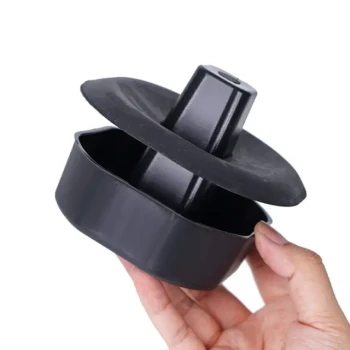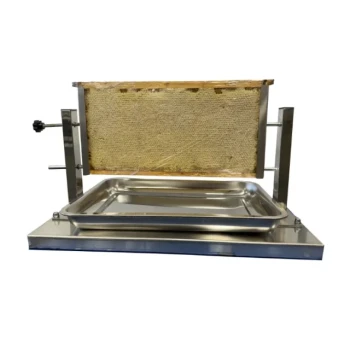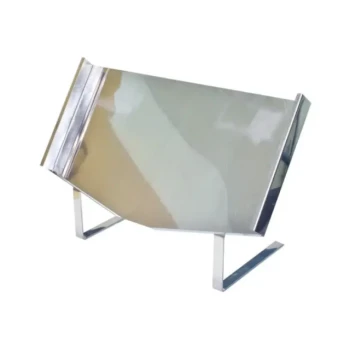For a successful beehive, the most critical factors to consider when choosing a location are adequate sunlight (especially in the morning), protection from strong winds, a nearby water source, and safe clearance from people and animals. These elements work together to create a stable, low-stress environment that allows the colony to defend itself from pests, regulate its temperature, and focus on foraging and reproduction.
The perfect hive location is a strategic compromise. It must balance the non-negotiable needs of the bees—sun, water, and shelter—with the practical needs of the beekeeper for safety and accessibility.
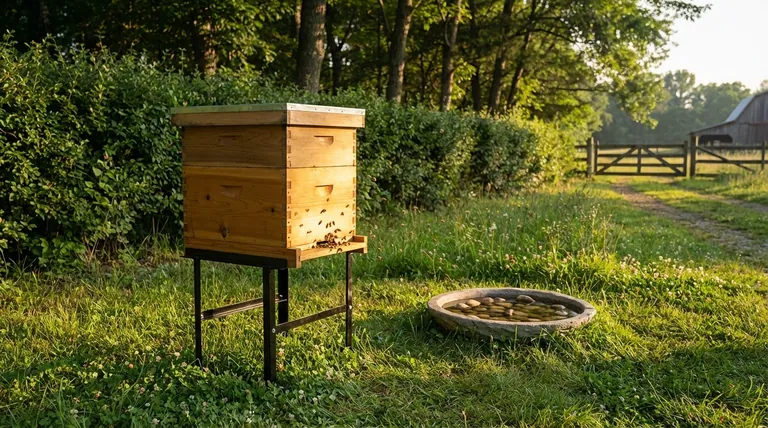
The Bee's Perspective: Core Environmental Needs
A colony's success is directly tied to its environment. Placing your hive in a location that meets the bees' natural requirements reduces their stress and allows them to dedicate their energy to productive tasks.
Sunlight: The Engine of the Hive
Sunlight, particularly morning sun, is a primary driver of hive activity. It warms the hive, encouraging bees to begin foraging earlier in the day.
This warmth also helps dry out any condensation, which reduces the risk of mold and chilled brood. Furthermore, sunny, dry conditions are less favorable for pests like small hive beetles and Varroa mites.
Wind Protection: Conserving Critical Energy
Hives exposed to constant, strong winds struggle to maintain their internal temperature of around 95°F (35°C). Bees must consume significant energy and honey stores just to stay warm.
Placing the hive behind a natural windbreak, such as a line of trees, a hedge, or a building, conserves this precious energy. This allows the colony to allocate more resources to raising brood and producing honey.
A Reliable Water Source: The Overlooked Necessity
Bees require a consistent source of water for several reasons: to cool the hive through evaporation on hot days, to drink, and to dilute crystallized honey to feed to larvae.
If a natural source like a pond or stream isn't within a quarter-mile, you must provide one. A birdbath with stones or a shallow dish with marbles gives them a safe place to land and drink without drowning.
The Beekeeper's Perspective: Safety & Practicality
While the bees' needs are paramount, a good location must also be practical and safe for you and those around you.
Accessibility: Your Gateway to Management
You will need to visit your hive regularly for inspections and maintenance. These visits often involve carrying heavy equipment and, hopefully, even heavier boxes of honey.
Ensure you can easily get to your hive, ideally with a wheelbarrow or cart. A location that is difficult to access often becomes a neglected one.
Flight Path Management: Ensuring Good Neighbors
A hive has a single entrance, and thousands of bees will be flying in and out. This creates a busy flight path extending directly in front of the hive.
Position the hive entrance so it faces away from walkways, decks, house entrances, or play areas. If you must place it near a high-traffic area, erect a fence or hedge about six feet in front of the hive. This forces the bees to fly up and over, minimizing interactions with people.
Level Ground: The Foundation of the Home
A beehive can become very tall and heavy, especially when full of honey. It is absolutely essential that it rests on a firm, level surface.
An unstable hive is at risk of toppling over in high winds or if bumped by an animal, which is a disaster for the colony and a danger to anyone nearby. Concrete blocks or a dedicated hive stand are excellent for providing a stable base.
Understanding the Trade-offs
No location is perfect. The key is to understand the compromises you are making.
Sun vs. Shade: The Climate Balancing Act
In cool or temperate climates, full sun is almost always beneficial. The warmth helps the colony build up faster in the spring and stay productive.
In extremely hot climates (e.g., the desert Southwest), relentless, all-day sun can cause the hive to overheat. In these regions, a location with direct morning sun and dappled afternoon shade is the ideal compromise.
Proximity vs. Seclusion: Your Convenience vs. Their Peace
It can be tempting to place a hive right outside your back door for easy viewing. However, this often conflicts with the need to keep bees away from people and pets.
A more secluded spot may require a longer walk, but it gives the bees the undisturbed space they need and drastically reduces the chance of unwanted stings. Always prioritize safety and seclusion over pure convenience.
Making the Right Choice for Your Property
Use these guidelines to select the best possible location based on your specific environment.
- If your primary focus is colony health in a cool or temperate climate: Prioritize a location that gets full morning sun to warm the hive and reduce dampness.
- If your primary focus is preventing overheating in a hot climate: Seek a spot with direct morning sun but guaranteed shade during the intense heat of the afternoon.
- If your primary focus is safety in a suburban or populated area: Your top priority is placing the hive away from people and directing the flight path upwards and away with a barrier.
- If your primary focus is efficiency in a rural or agricultural setting: Concentrate on year-round vehicle accessibility for hive management and ensuring protection from open-field winds and livestock.
The ideal hive location works in harmony with nature and your surroundings, ensuring your bees are not just surviving, but thriving.
Summary Table:
| Key Factor | Why It Matters | Ideal Condition |
|---|---|---|
| Sunlight | Warms the hive, dries condensation, deters pests | Morning sun, with afternoon shade in hot climates |
| Wind Protection | Conserves bee energy used for temperature regulation | Behind a natural windbreak (trees, hedge, building) |
| Water Source | Essential for cooling, drinking, and feeding larvae | Natural source within 1/4 mile or a provided safe waterer |
| Safety & Flight Path | Minimizes bee-human interactions, prevents stings | Entrance faces away from traffic, use a barrier if needed |
| Accessibility & Level Ground | Ensures easy hive management and prevents toppling | Firm, level base; accessible with equipment year-round |
Ready to build a thriving apiary?
Selecting the perfect hive location is the first step to a productive season. The next is equipping yourself with durable, reliable supplies designed for commercial success.
HONESTBEE is your trusted wholesale partner, supplying commercial apiaries and beekeeping equipment distributors with the high-quality gear needed to manage hives efficiently and safely. From robust hive stands that ensure stability on any terrain to protective gear and essential tools, we support your operation's growth and productivity.
Let's discuss your specific needs. Contact our expert team today to get tailored recommendations and wholesale pricing on the equipment that helps your bees—and your business—thrive.
Visual Guide
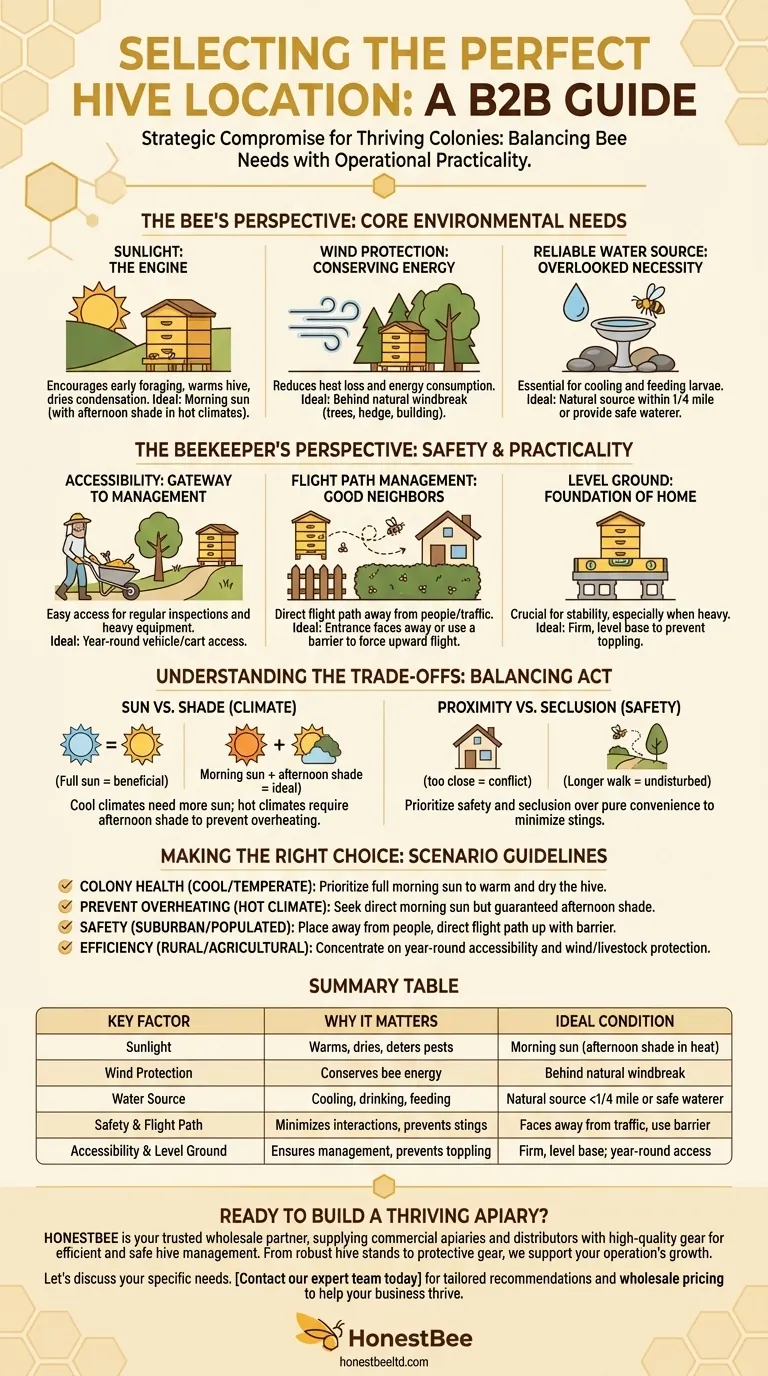
Related Products
- Metal Bee Hive Stand Bee Box Stand for Beekeeping
- Metal Hive Feet Bee Hive Stand for Ant Protection
- Plastic Bee Hive Stand for Beekeeping
- Professional Ant-Proof Beehive Stand with Integrated Moat for Beekeeping
- Yellow Plastic Bucket Pail Perch for Beekeeping
People Also Ask
- How do bees regulate ventilation and temperature in the hive? Master Hive Climate Control
- Should beehives be in sun or shade? Find the Perfect Balance for a Thriving Hive
- Do I need a hive stand? Essential for Bee Health & Easier Beekeeping
- Why is proper beekeeping equipment important? Essential for Safety and Hive Health
- What is the purpose of a hive stand, and why is it beneficial? Elevate Your Hive for Colony Health and Beekeeper Comfort



